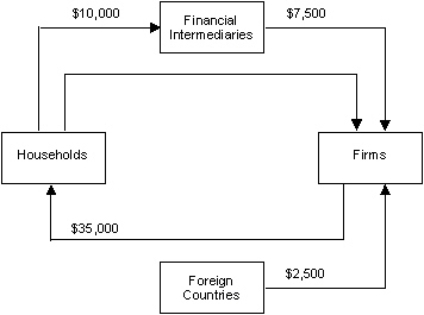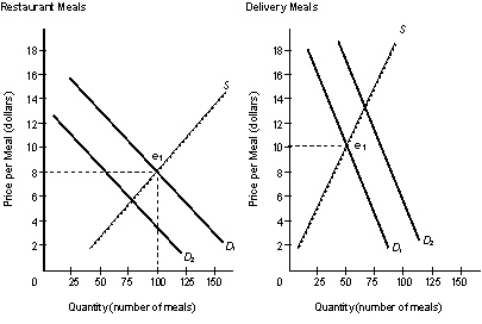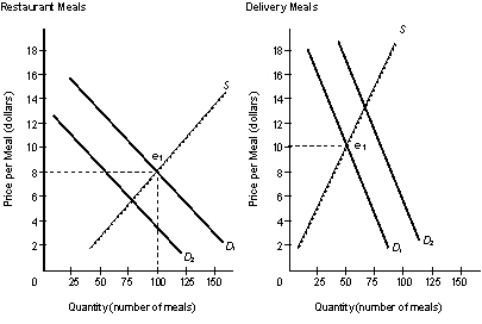A) a country imposes a price floor.
B) a country's imports exceed its exports.
C) a country imposes a price ceiling.
D) a country's exports exceed its imports.
E) when the domestic product market is in disequilibrium.
Correct Answer

verified
Correct Answer
verified
Multiple Choice
Which of the following is true of Western Europe, Japan, Canada, Mexico, and China taken together?
A) All these countries are classified as high-income countries by the World Bank.
B) They are all members of the North American Free Trade Agreement [NAFTA].
C) All these countries are considered developed countries by the World Bank.
D) They are collectively the largest trade partners of the U.S.
E) They are the five largest exporters of agricultural produce in the world.
Correct Answer

verified
Correct Answer
verified
Multiple Choice
The figure given below represents the circular flow of income between households, firms, financial intermediaries, and foreign countries. Figure 4.2  Refer to Figure 4.2.Assume investment spending decreases by $4, 000.Everything else being the same, what must be the new value of net trade flows in order to maintain total expenditures on business firms' output at $35, 000?
Refer to Figure 4.2.Assume investment spending decreases by $4, 000.Everything else being the same, what must be the new value of net trade flows in order to maintain total expenditures on business firms' output at $35, 000?
A) -$2, 500
B) -$1, 500
C) $3, 500
D) $6, 500
E) $7, 500
Correct Answer

verified
Correct Answer
verified
True/False
A household consists of only related family members like a father, mother, and children and not unrelated members like two students sharing a rented apartment.
Correct Answer

verified
Correct Answer
verified
Multiple Choice
Which of the following institutions form the private sector in an economy?
A) Only households
B) Households and the government
C) Households, businesses, and foreign firms
D) Households and businesses only
E) Foreign investors and foreign governments
Correct Answer

verified
Correct Answer
verified
Multiple Choice
A country is categorized as a low-income economy by the World Bank if its per capita income is below:
A) $1, 000.
B) $100.
C) $10, 000
D) $50.
E) $5, 000.
Correct Answer

verified
Correct Answer
verified
Multiple Choice
The figure given below represents the equilibrium price and output in the market for restaurant meals and delivery meals. Figure 4.1  Refer to Figure 4.1.In which direction will the resources flow following a shift in the demand for Restaurant Meals and Delivery Meals as represented by the figure?
Refer to Figure 4.1.In which direction will the resources flow following a shift in the demand for Restaurant Meals and Delivery Meals as represented by the figure?
A) Resources flow from where they are more highly valued to where they are less highly valued in order to make the consumer better off.
B) Resources flow from where they are more highly valued to where they are less highly valued in order to reduce prices.
C) Resources flow from where they are more highly valued to where they are less valued in order to reduce costs.
D) Resources flow from Restaurant production and sales to Delivery production and sales.
E) Resources flow to Restaurant production and sales and away from Delivery production and sales.
Correct Answer

verified
Correct Answer
verified
Multiple Choice
The term consumer sovereignty refers to:
A) the fact that consumers' choices are limited to what the producers decide to produce.
B) a situation in which the government decides what is produced.
C) the idea that consumers ultimately determine what is produced.
D) the idea that consumers try to maximize their utility.
E) the idea that the preferences of both producers and the government ultimately determine what is produced.
Correct Answer

verified
Correct Answer
verified
Multiple Choice
The wireless communication business has changed dramatically since the 1980s, going from mobile phones to smartphones.This was only possible because:
A) of the persuasive advertising campaigns undertaken by firms in the wireless communication industry.
B) consumers welcomed the changes and were willing and able to pay for them.
C) of the dot-com stock market bubble that lasted from 1995 to 2000.
D) the government tightly regulated the wireless communication industry with regulations and taxes.
E) businesses needed to produce these products in order to recoup their investment in research and development.
Correct Answer

verified
Correct Answer
verified
Multiple Choice
Based on the fact that the companies Ford, IBM, PepsiCo, and McDonald's own and operate units in many different countries, they are categorized as:
A) joint ventures.
B) sole proprietorship firms.
C) partnership firms.
D) multinational firms.
E) co-operative firms.
Correct Answer

verified
Correct Answer
verified
True/False
When the government sector is included in the circular flow diagram, the total value of private production will equal the value of household income.
Correct Answer

verified
Correct Answer
verified
Multiple Choice
In a market system, which of the following factors determines a consumers's ability to pay for a good or service?
A) Technology
B) Consumer's income
C) Cost of production
D) Consumer's wants
E) Market supply
Correct Answer

verified
Correct Answer
verified
Multiple Choice
In a market system, consumer demands dictate _____ and the search for profit defines _____.
A) for whom goods and services are produced;how goods and services are produced
B) what is produced;for whom goods and services are produced
C) where goods and services are produced;for whom goods and services are produced
D) what is produced;where goods and services are produced
E) what is produced;how goods and services are produced
Correct Answer

verified
Correct Answer
verified
Multiple Choice
Total government spending in the U.S.economy was around _____ of GDP in the financial year 2010.
A) 5 percent
B) 36 percent
C) 25 percent
D) 44 percent
E) 16 percent
Correct Answer

verified
Correct Answer
verified
Multiple Choice
Mark's ability to purchase goods and services depends on:
A) his aesthetic sense.
B) his ability to hunt out the best bargains.
C) the amount of information that he has.
D) his money income.
E) his intelligence level.
Correct Answer

verified
Correct Answer
verified
True/False
Consumption or household spending of an economy comprises of both consumer spending and business spending.
Correct Answer

verified
Correct Answer
verified
True/False
A person obtains income is obtained by selling the services of the resources that he or she owns.
Correct Answer

verified
Correct Answer
verified
Multiple Choice
A surplus in a country's trade balance means that:
A) net exports exceed transfer payments.
B) the country's currency is over-valued.
C) the value of net exports is positive.
D) imports into the country exceed exports.
E) domestic savings exceeds domestic investment.
Correct Answer

verified
Correct Answer
verified
Multiple Choice
The figure given below represents the equilibrium price and output in the market for restaurant meals and delivery meals. Figure 4.1  Refer to Figure 4.1.If the price in the Delivery Meals market remains at $10 but demand shifts to D2 which of the following situations will be observed?
Refer to Figure 4.1.If the price in the Delivery Meals market remains at $10 but demand shifts to D2 which of the following situations will be observed?
A) People would be willing and able to purchase 75 units while only 60 units would be available.
B) People would be willing and able to purchase only 60 units while 75 units would be available.
C) People would be willing and able to purchase 75 units while only 50 units would be available.
D) People would be willing and able to purchase 75 units while only 25 units would be available.
E) People would be willing and able to purchase 50 units and producers would supply exactly 50 units.
Correct Answer

verified
Correct Answer
verified
True/False
The replacement of film-based still cameras by digital cameras and recently by digital SLR cameras exemplifies creative destruction.
Correct Answer

verified
Correct Answer
verified
Showing 41 - 60 of 97
Related Exams